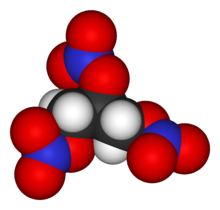ไนโตรกลีเซอรีน
สารที่ใช้ทำ ระเบิดไดนาไมต์
(เปลี่ยนทางจาก Glyceryl trinitrate)
ไนโตรกลีเซอรีน (อังกฤษ: Nitroglycerin) มีชื่ออื่นๆ เช่น ไนโตรกลีเซอรีน (trinitroglycerin) , กลีเซอรีล ไตรไนเตรต (glyceryl trinitrate) เป็นต้น เป็นสารประกอบทางเคมีชนิดหนึ่ง ปกติเป็นของเหลว ระเบิดได้ ลื่นมัน เป็นพิษ ไม่มีสี และหนัก ได้จากการไนเตรตสารกลีเซอรอล นิยมใช้ในการผลิตวัตถุระเบิด โดยเฉพาะไดนาไมต์ และใช้ในอุตสาหกรรมการก่อสร้างและรื้อทำลาย นอกจากนี้ยังมีใช้ในการแพทย์ เพื่อขยายหลอดเลือดหัวใจ ในคนไข้ที่เป็นโรคหัวใจ

| |

| |

| |
| ชื่อ | |
|---|---|
| Preferred IUPAC name
Propane-1,2,3-triyl trinitrate | |
ชื่ออื่น
| |
| เลขทะเบียน | |
3D model (JSmol)
|
|
| 1802063 | |
| ChEBI | |
| ChEMBL | |
| เคมสไปเดอร์ | |
| ดรักแบงก์ | |
| ECHA InfoCard | 100.000.219 |
| EC Number |
|
| 165859 | |
| KEGG | |
| MeSH | Nitroglycerin |
ผับเคม CID
|
|
| UNII | |
| UN number | 0143, 0144, 1204, 3064, 3319 |
CompTox Dashboard (EPA)
|
|
| |
| |
| คุณสมบัติ | |
| C3H5N3O9 | |
| มวลโมเลกุล | 227.085 g·mol−1 |
| ลักษณะทางกายภาพ | Colorless liquid |
| ความหนาแน่น | 1.6 g⋅cm−3 (at 15 °C) |
| จุดหลอมเหลว | 14 องศาเซลเซียส (57 องศาฟาเรนไฮต์; 287 เคลวิน) |
| จุดเดือด | 50 องศาเซลเซียส (122 องศาฟาเรนไฮต์; 323 เคลวิน) Explodes |
| Slightly[1] | |
| ความสามารถละลายได้ | Acetone, ether, benzene, alcohol[1] |
| log P | 2.154 |
| โครงสร้าง | |
| |
| |
| ข้อมูลระเบิด | |
| ความไวต่อแรงกระแทก | High |
| ความไวต่อแรงเสียดทาน | High |
| ความเร็วการระเบิด | 7700 m⋅s−1 |
| RE factor | 1.50 |
| อุณหเคมี | |
Std enthalpy of
formation (ΔfH⦵298) |
−370 kJ⋅mol−1 |
Std enthalpy of
combustion (ΔcH⦵298) |
−1.529 MJ⋅mol−1 |
| เภสัชวิทยา | |
| C01DA02 (WHO) C05AE01 | |
| Intravenous, by mouth, under the tongue, topical | |
| เภสัชจลนศาสตร์: | |
| <1% | |
| Liver | |
| 3 min | |
| สถานะทางกฎหมาย |
|
| ความอันตราย | |
| อาชีวอนามัยและความปลอดภัย (OHS/OSH): | |
อันตรายหลัก
|
Explosive, toxic |
| GHS labelling: | |
   
| |
| อันตราย | |
| H202, H205, H241, H301, H311, H331, H370 | |
| P210, P243, P250, P260, P264, P270, P271, P280, P302+P352, P410 | |
| NFPA 704 (fire diamond) | |
| NIOSH (US health exposure limits): | |
PEL (Permissible)
|
C 0.2 ppm (2 mg/m3) [skin][2] |
หากมิได้ระบุเป็นอื่น ข้อมูลข้างต้นนี้คือข้อมูลสาร ณ ภาวะมาตรฐานที่ 25 °C, 100 kPa
| |
ผู้ค้นพบคือ อัสซานิโอ โซเบรโร(Ascanio Sobrero)
ไนโตรกลีเซอรีน () หรือที่รู้จักในชื่อของไดนาไมต์ ซึ่งเป็นวัตถุระเบิดที่มีความรุนแรงสามเท่าของดินปืน
ค้นพบได้อย่างไร:ไนโตรกลีเซอรีน
แก้หากผสมกลีเซอรอลเข้ากับกรดซัลฟูริกและกรดไนตริก จะได้เป็นไนโตรกลีเซอรีน
อ้างอิง
แก้- ↑ 1.0 1.1 "Occupational Safety and Health Guideline for Nitroglycerin". คลังข้อมูลเก่าเก็บจากแหล่งเดิมเมื่อ 16 พฤษภาคม 2013. สืบค้นเมื่อ 19 ตุลาคม 2016.
- ↑ NIOSH Pocket Guide to Chemical Hazards. "#0456". National Institute for Occupational Safety and Health (NIOSH).
- ↑ "Hazard Rating Information for NFPA Fire Diamonds". คลังข้อมูลเก่าเก็บจากแหล่งเดิมเมื่อ 17 กุมภาพันธ์ 2015.
แหล่งข้อมูลอื่น
แก้วิกิมีเดียคอมมอนส์มีสื่อที่เกี่ยวข้องกับ ไนโตรกลีเซอรีน
- "Nitroglycerine! Terrible Explosion and Loss of Lives in San Francisco". Central Pacific Railroad Photographic History Museum. สืบค้นเมื่อ 2005-03-23. – 1866 Newspaper article
- WebBook page for C3H5N3O9
- CDC - NIOSH Pocket Guide to Chemical Hazards
- The Tallini Tales of Destruction Detailed and horrific stories of the historical use of nitroglycerin-filled torpedoes to restart petroleum wells.
- Dynamite and TNT at The Periodic Table of Videos (University of Nottingham)

